AMD Radeon HD 7870 GHz Edition & HD 7850 Review
Earlier this week AMD took the wraps off the latest entries into its Radeon HD 7000 series, the Radeon HD 7870 GHz Edition (GE) and the Radeon HD 7850. The HD 7800 family is billed as a replacement to the HD 6900 series. From a price and specifications standpoint, that looks to be the case. The "flagship" models in the HD 6000-series (the 6970 and 6950) each had 2GB of VRAM and carried price tags of $349 and $279. The 7800 family has the same 2GB of VRAM (as expected, considering that the 7900 family came with 3GB), and price points of $349 and $249.
In their press materials, AMD bills the Radeon HD 7800 "Pitcairn" platform with the tagline "Serious gaming starts here". Two generations ago, with the launch of the Radeon HD 5870 and Eyefinity, the x800 family was seen as the flagship and the x900 moniker was reserved for the dual-GPU card (the Radeon DH 5970). The 6000-series moved the flagship "enthusiast" cards into the x900 family (the HD 6970 and the HD 6950) and edged up the dual-GPU to carry the top end of the naming with the HD 6990 badging.
The 6800 family was great in widescreen, but could be hampered in Eyefinity to the 1GB VRAM limitation. The 6900 was reserved for high-end Eyefinity gaming, due to carrying 2GB of VRAM. The 7800 family now sports the 2GB of VRAM of the enthusiast class cards in the "performance" tier, but it also now sports the $350 - $250 price range of the 6900 series.

Architecture & Specs
Spec-wise, the Radeon HD 7870 and 7850 slot in between the 6800 and 6900 families - though remember it is on the new GCN architecture.
| Card | GPUs | Transistors | Memory | Bus Width | Shaders | Clock (MHz) | TDP (Watts)* | Power | MSRP | ||
| Core | Mem | Idle | Max | ||||||||
| AMD Radeon HD 7970 | 1 | 4.3B on 28nm | 3GB | 384-bit | 2,048 | 925 | 1,375 | <3 | 250* | 8+6-pin | $549 |
| AMD Radeon HD 7950 | 1 | 4.3B on 28nm | 3GB | 384-bit | 1,792 | 800 | 1,250 | <3 | 200* | 6+6-pin | $449 |
| AMD Radeon HD 7870 | 1 | 2.8B on 28nm | 2GB | 256-bit | 1,280 | 1,000 | 1,200 | <3 | 175* | 6+6-pin | $349 |
| AMD Radeon HD 7850 | 1 | 2.8B on 28nm | 2GB | 256-bit | 1,024 | 860 | 1,200 | <3 | 130* | 6-pin | $249 |
| AMD Radeon HD 6970 | 1 | 2.6B on 40nm | 2GB | 256-bit | 1,536 | 880 | 1,375 | 20 | 250* | 8+6-pin | $349 |
| AMD Radeon HD 6950 | 1 | 2.6B on 40nm | 2GB | 256-bit | 1,408 | 800 | 1,250 | 20 | 200* | 6+6-pin | $279 |
| AMD Radeon HD 6870 | 1 | 1.8B on 40nm | 1GB | 256-bit | 1,120 | 900 | 1,050 | 19 | 151 | 6+6-pin | $239 |
| AMD Radeon HD 6850 | 1 | 1.8B on 40nm | 1GB | 256-bit | 960 | 775 | 1,000 | 19 | 127 | 6-pin | $179 |
| *These values represent the maximum wattage allowed through the AMD PowerTune. Idle for the 7000-series is based on a "long idle" scenario. | |||||||||||
AMD Radeon HD 7870 GHz Edition & HD 7850 Review - Benchmarking
System Specs
I have updated my resting rig, and moved from an Intel Core i7-920 to an i7-2600k. As before, everything runs at stock clock speeds. I have also increased RAM from 12GB to 16GB.
- Windows 7
- ASUS P8Z68-V Pro/Gen3
- Intel i7 2600k at 4x3.4GHz
- 16GB G.Skill DDR3 1.25v low-voltage RAM
- 2x Samsung 320GB T-Series HDD (one for the OS and games; one for swap file and FRAPS)
- LG Super Multi Blu (HD-DVD/Blu-Ray Player)
- Onboard audio
- Corsair HX1000
- My Open PC Dragon Case
- Logitch K340 Keyboard & Performance MX Mouse
- Ergotech Heavy Duty Triple Desk Stand - WSGF Edition
- 3x Dell U2211H IPS 16:9 1920x1080 Displays
Hardware Tested
I only have AMD hardware tested for comparison in this review. This is not for lack of wanting to test NVIDIA hardware in Surround, but NVIDIA has not yet decided to support the WSGF with hardware for review and benchmarking. Considering that the WSGF is a hobby that just supports itself, I cannot justify spending the money needed to test NVIDIA cards.
Most of my time is spent working on the site (or other projects), and much of my "play time" is spent benchmarking. Cards would basically only be used for testing, and I cannot reconcile purchasing cards that would only be used for testing. It's simply not a good ROI.
Resolutions Tested
I tested both 1600x900 and 1920x1080 in widescreen, as well as 4800x900 and 5760x1080 in 3x1-L Eyefinity.
Games Tested
I have overhauled my suite of games. I replaced some older titles with their sequels, and I've simply dropped some titles either due to age or the time needed to benchmark. Additionally, I've dropped the DX9 and DX10 tests from the Heaven demo.
- Aliens vs. Predators
- DiRT 3
- H.A.W.X. 2
- Heaven v2.5 DX11
- Mafia II
- Metro 2033
- Total War: Shogun 2
As always, all games are tested at max settings (unless otherwise noted), with 4xAA and 16xAF enabled.
AMD Radeon HD 7870 GHz Edition & HD 7850 Review - Aliens vs. Predator
Still demanding DX11 benchmark that we've used for a while here on the WSGF. Though it's closing in on two years old, the AvP stand-alone benchmark tool is still a good test of DX11 hardware. It isn't very demanding from a CPU perspective, so it gives a good test of the GPU itself.
The AvP demo also makes good usage of DX11 effects such as Advanced Shadows and Geometry Tessellation, particularly on the alien create and the alien "pods". There are also some unique lighting effects used, by placing mobile lighting sources in a floor lamp that is battered around by the alien creatures as they clamor down a tight hallway.
The HD 7800 family "trades jabs" with the HD 6900 family in widescreen. The HD 7870 just edges out the HD 6970, while the HD 6950 just edges out the HD 7850. All in all, they perform relatively on par with each other. Just remember that this is occurring at a much lower power profile, with reduced heat and noise as well. We see similar performance in Eyefinity. The HD 6970 and HD 7870 tie in performance, with the HD 6950 just edging out the HD 7850.
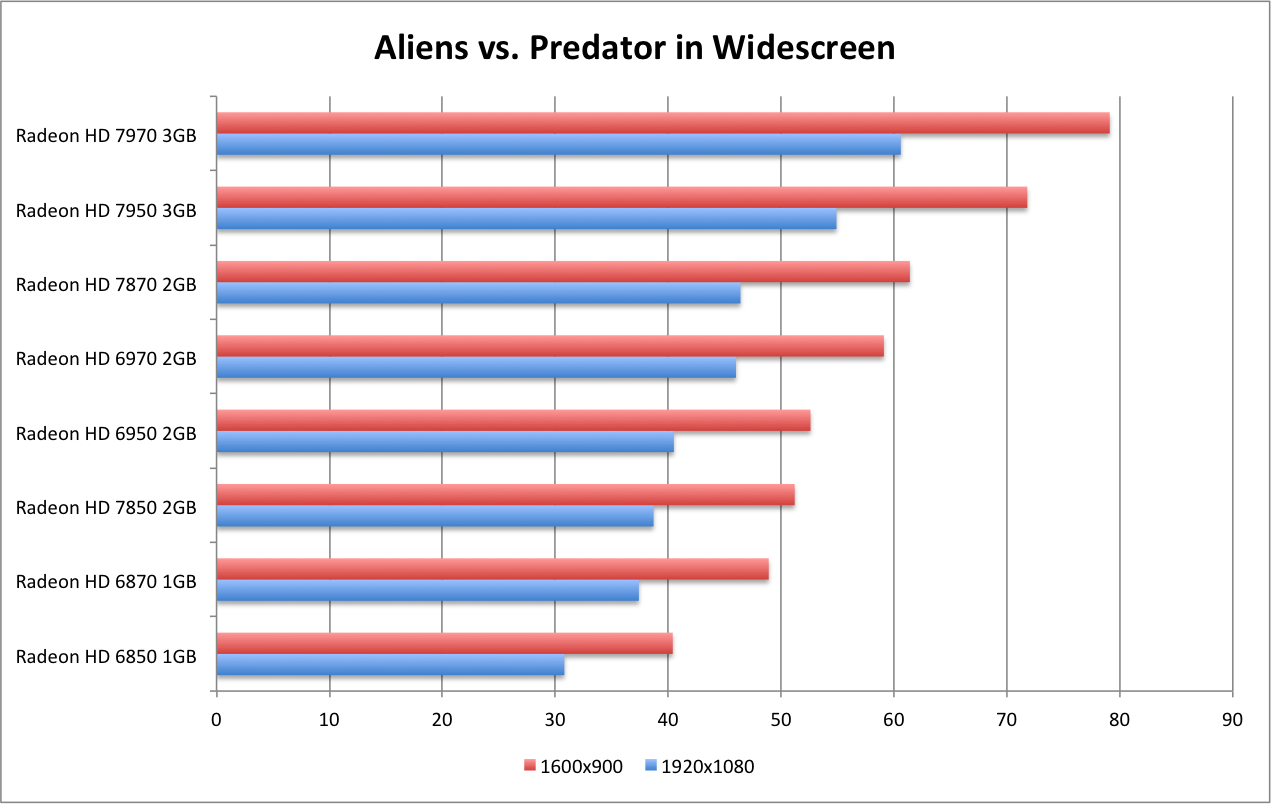

AMD Radeon HD 7870 GHz Edition & HD 7850 Review - DiRT 3
Dirt 3 has replaced our previous benchmark of Dirt 2. The Dirt 2 benchmark was the "urban" London circuit, which had several nice examples of water tessellation for the gar to drive through. The Dirt 3 benchmark we use is the Aspen track, which is a long winding snow course.
Rather than water and cloth effects in Drt 2, the Dirt 3 course showcases snow covered trees that flank a snow-covered course with tessellation effects on the snow tracks gouged into the snow. Additionally, there are continuous snow particles kicked up from the cars, and a better chance to see cars flipping and skidding. Overall, a nice and "pretty" update to our Dirt 2 benchmark.
We similar performance between the Radeon HD 7800 and the Radeon HD 6900 families. In widescreen, we see a tie at 1600x900, with the Radeon HD 7870 pulling ahead of the HD 6970. The HD 7850 comes in just under the HD 6950 in widescreen. Similar performance story in Eyefinity as well.

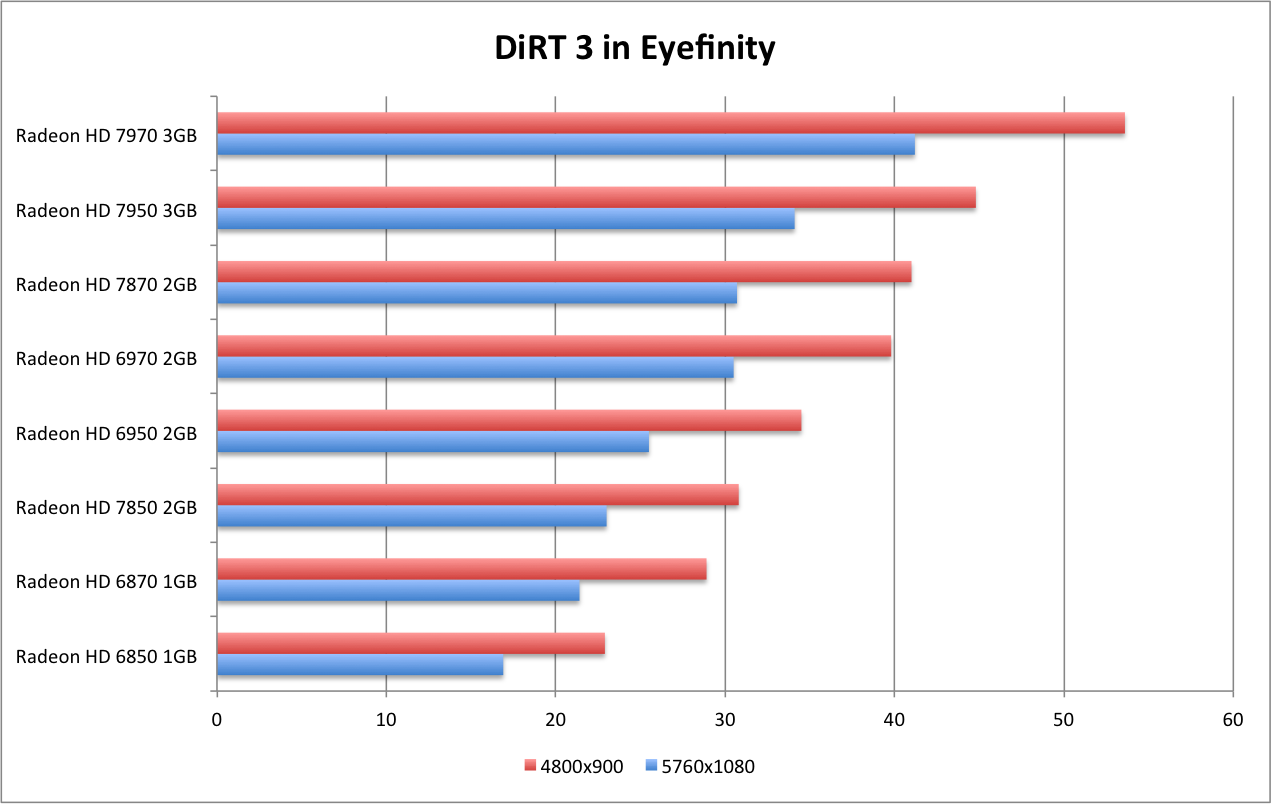
AMD Radeon HD 7870 GHz Edition & HD 7850 Review - H.A.W.X. 2
Sequel to the original HAWX title. This title updates the original by moving from DX10 to DX11, and utilizing tessellation on the mountainous landscape. The original HAWX demo provided a simple camera fly-through of an area populated by detailed cities and waterways. The "action" consisted mostly of ground explosions and some aircraft engagement.
The HAWX 2 demo removes the cities and water, and focuses on very detailed snow-covered mountain range with a large fleet of aircraft firing missiles. The viewpoint of the camera alternates between a third-person view over the top of a jet, as well as a first-person view inside the same craft.
We do see sizable wins by the Radeon HD 7800 family in HAWX 2, over the Radeon HD 6800. In widescreen the new cards best the previous models by almost 30%, and in Eyefinity we see improvements of almost 40%.
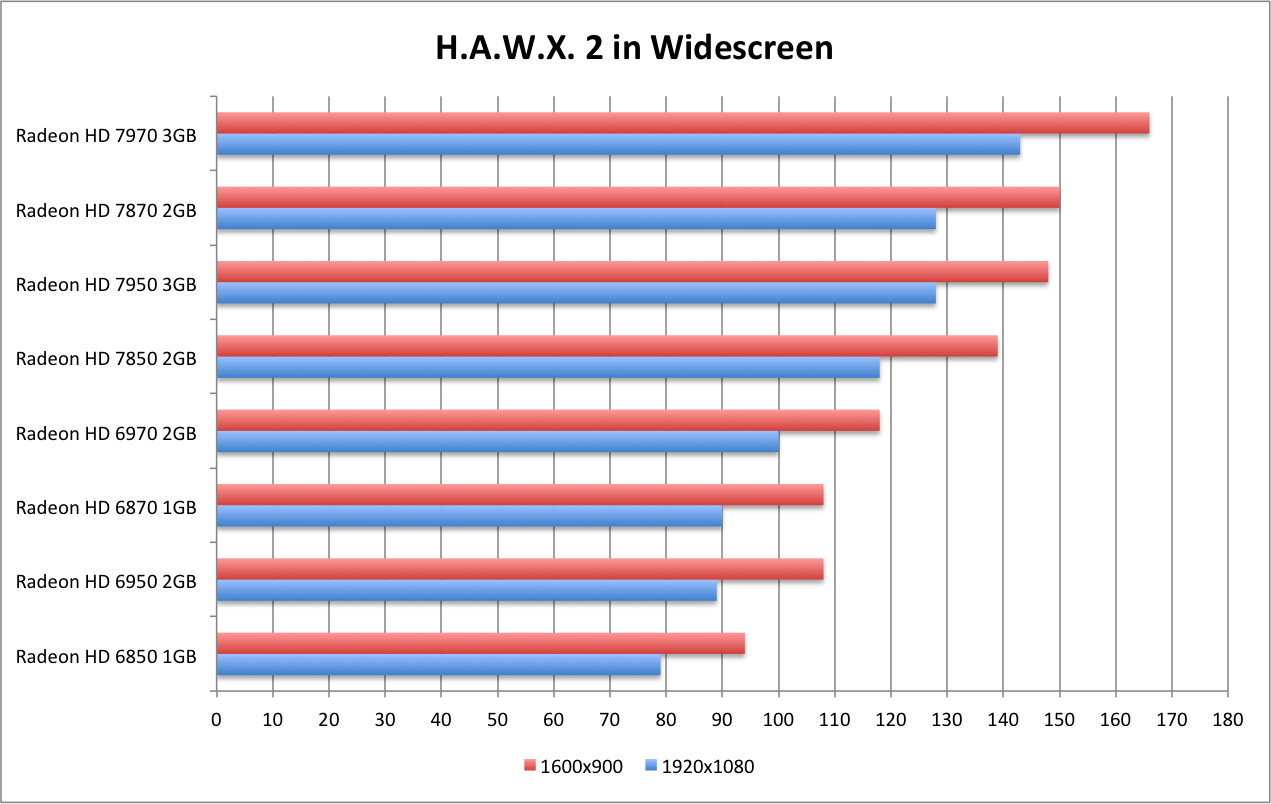
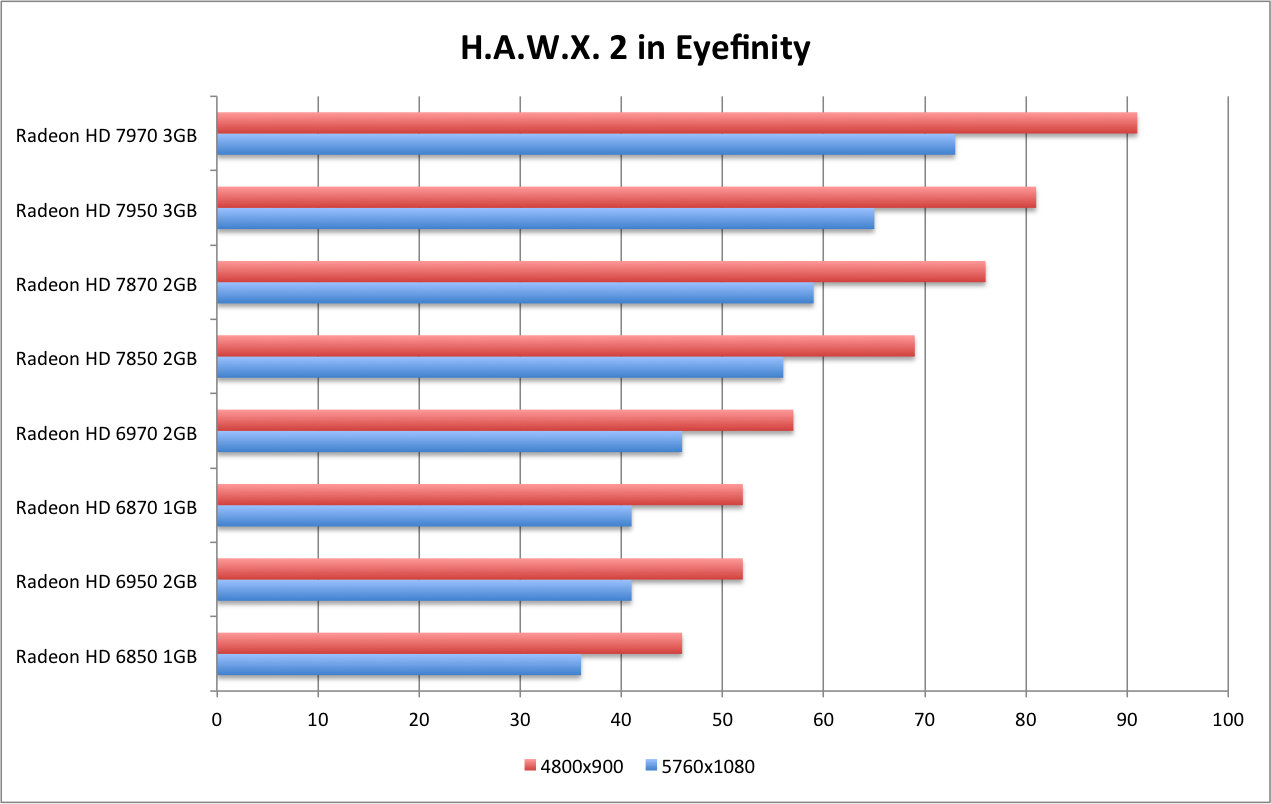
AMD Radeon HD 7870 GHz Edition & HD 7850 Review - Heaven 2.5 DX11
Update to the Heaven v2 demo, that has been an long-standing benchmark for many people. Though it's largely the same as the v2 demo, it does add a couple of new set pieces - particularly a new airship. This title is more demanding than the previous iteration, and adds a new tessellation options.
The Heaven demo continues to offer options for testing in DX9, DX10 and DX11 code paths. We have narrowed our testing to DX11, and are no longer testing the DX9 and DX10 code paths. The DX9 and DX10 were more CPU dependent and less of a test of the strength or weakness of the GPU. The DX11 truly stresses a GPU.
We see strong performance with the Radeon HD 7870 and HD 7850. In widescreen, the 1 GHz clock speed of the HD 7870 pulls it into second place, ahead of even the Radeon HD 7950. Both cards come out on top against the HD 6900 family. In Eyefinity, they come in a few frames under the HD 6900 family.
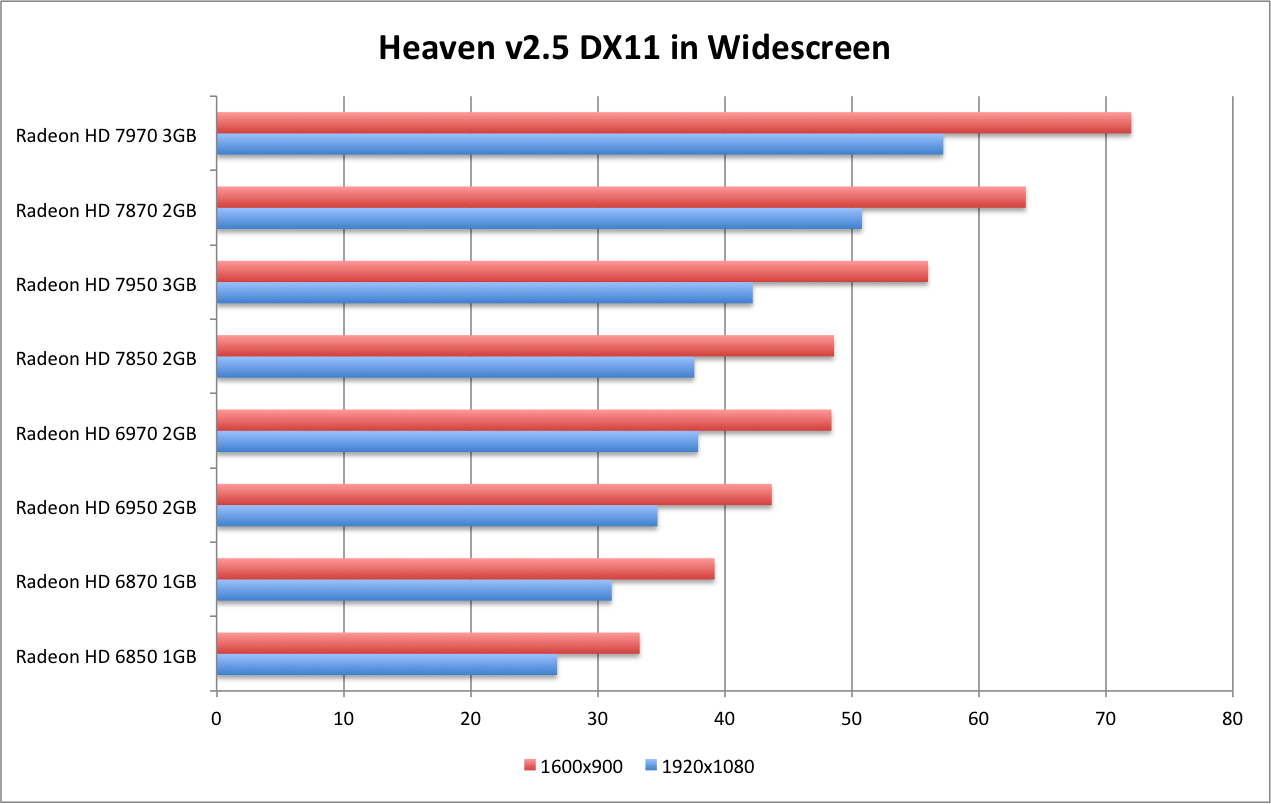
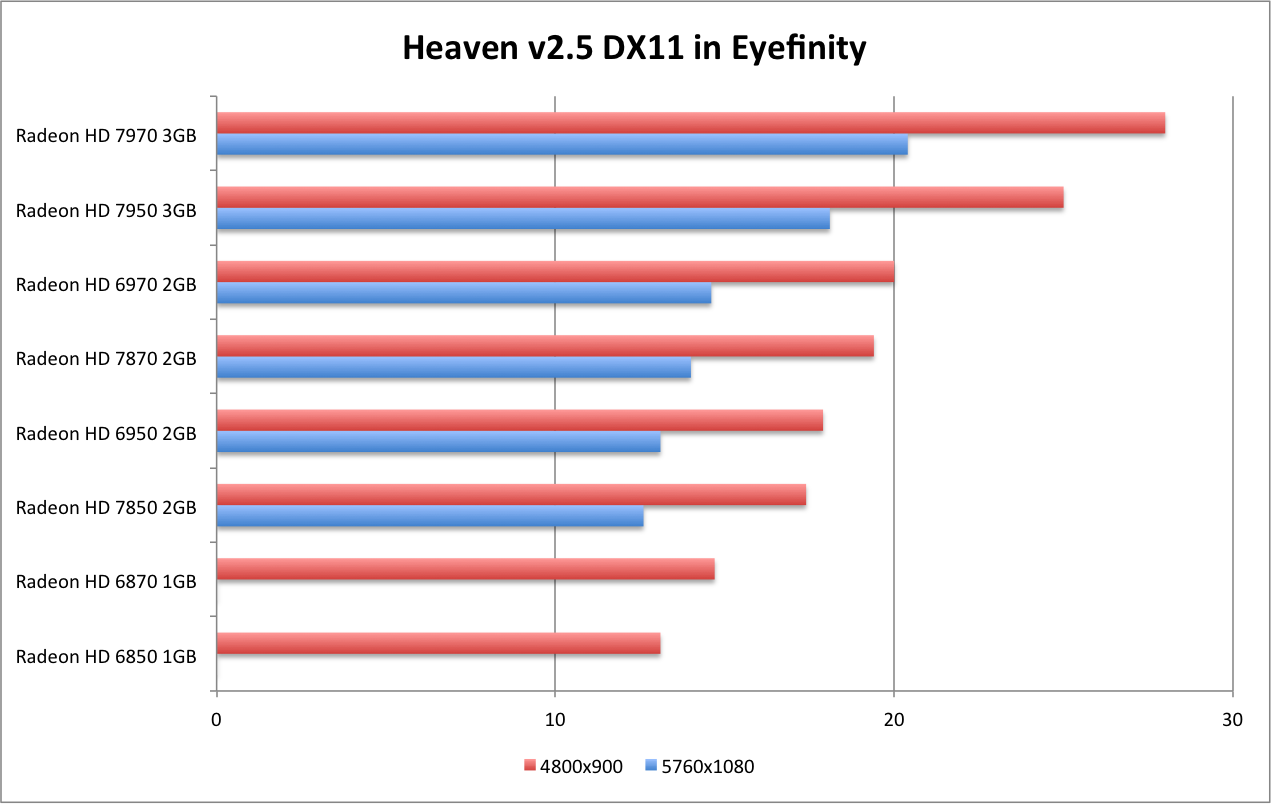
AMD Radeon HD 7870 GHz Edition & HD 7850 Review - Mafia II
Demanding benchmark that is included in the Mafia II open-world crime title. The title begins with an exterior gunfight, highlighting cars losing parts and being destroyed. The demo then moves inside a warehouse which highlights a gun battle, with destructible environments (brick columns) and excellent flame effects.
One thing to note is that the demo performs much better on a second run-through. The first run shows noticeable hiccups during the loading of different scenes. Subsequent runs run much smoother, though the overall average isn't seriously effected.
In the pattern we keep seeing, the Radeon HD 7800 cards trade performance spots with their partners in the HD 6900 family. In Eyefinity, the HD 7800 series pull performance improvements of about 15% over their HD 6800 counterparts.
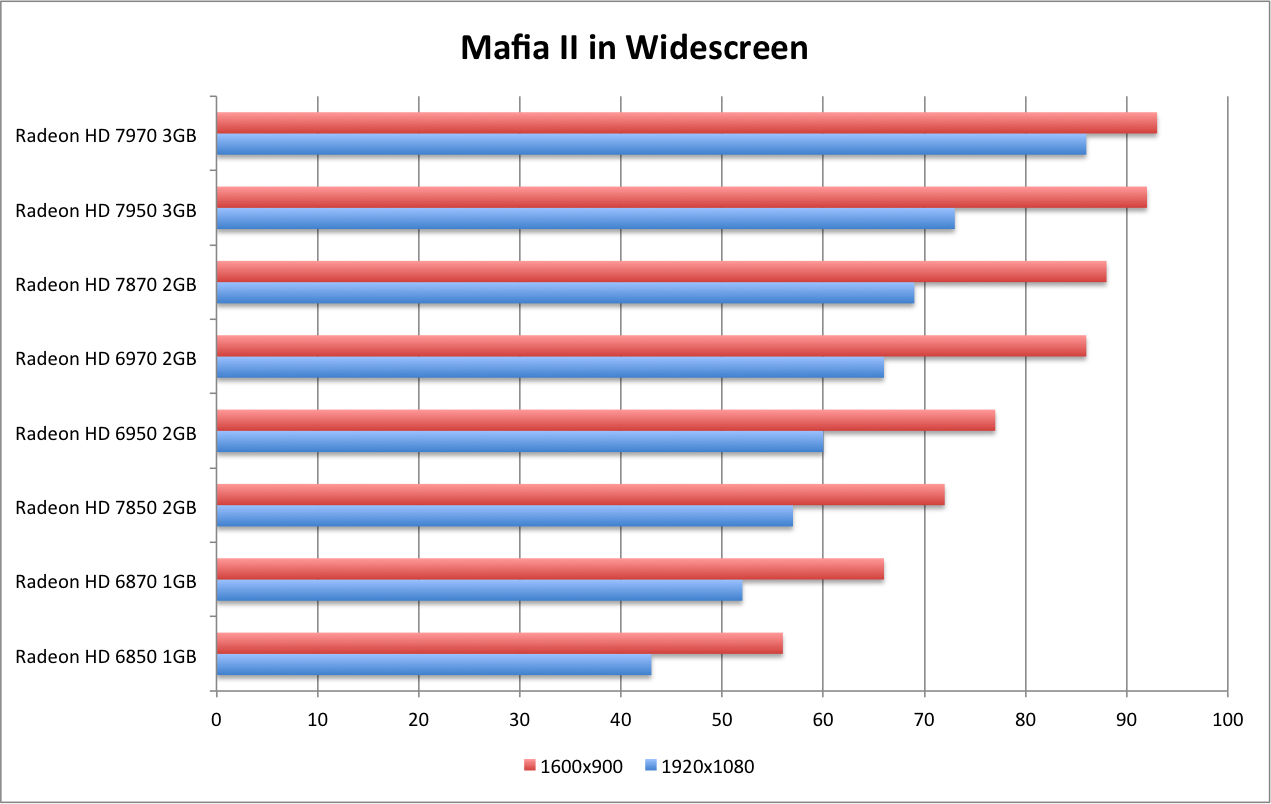
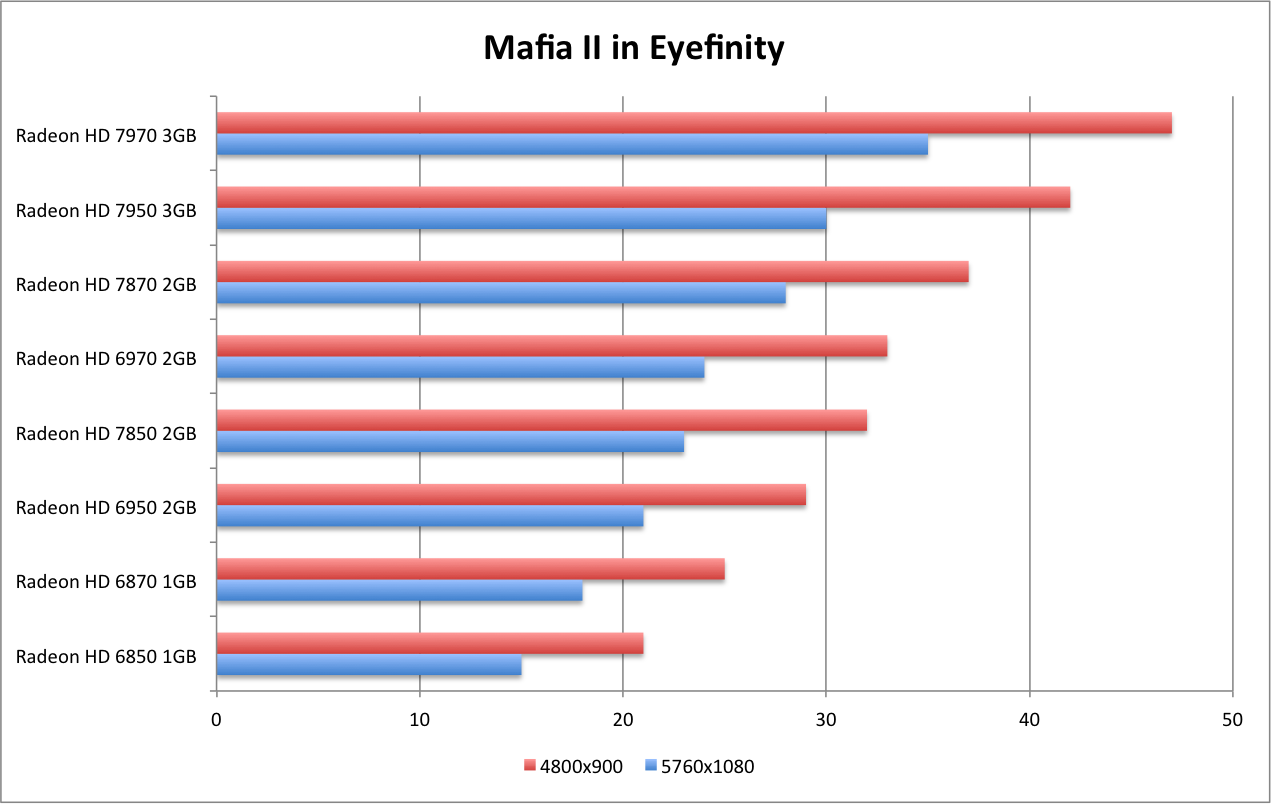
AMD Radeon HD 7870 GHz Edition & HD 7850 Review - Metro 2033
Demanding benchmark that is included in the popular FPS, Metro 2033. The demo is a camera fly through in a subway tunnel. There are large amounts of gunfire, cloth and lighting effects. The demo has a number of noticeable slowdowns from heavy flame, fog and motion blur effects. We run the game on the DX11 code path.
One a single GPU we see a number of dips, similar to Far Cry 2. When running in CrossFire multi-GPU, I do see noticeable micro-stuttering.
Same pattern as before, the HD 7800 performs on par with the HD 6900 and far outstrips the HD 6800.
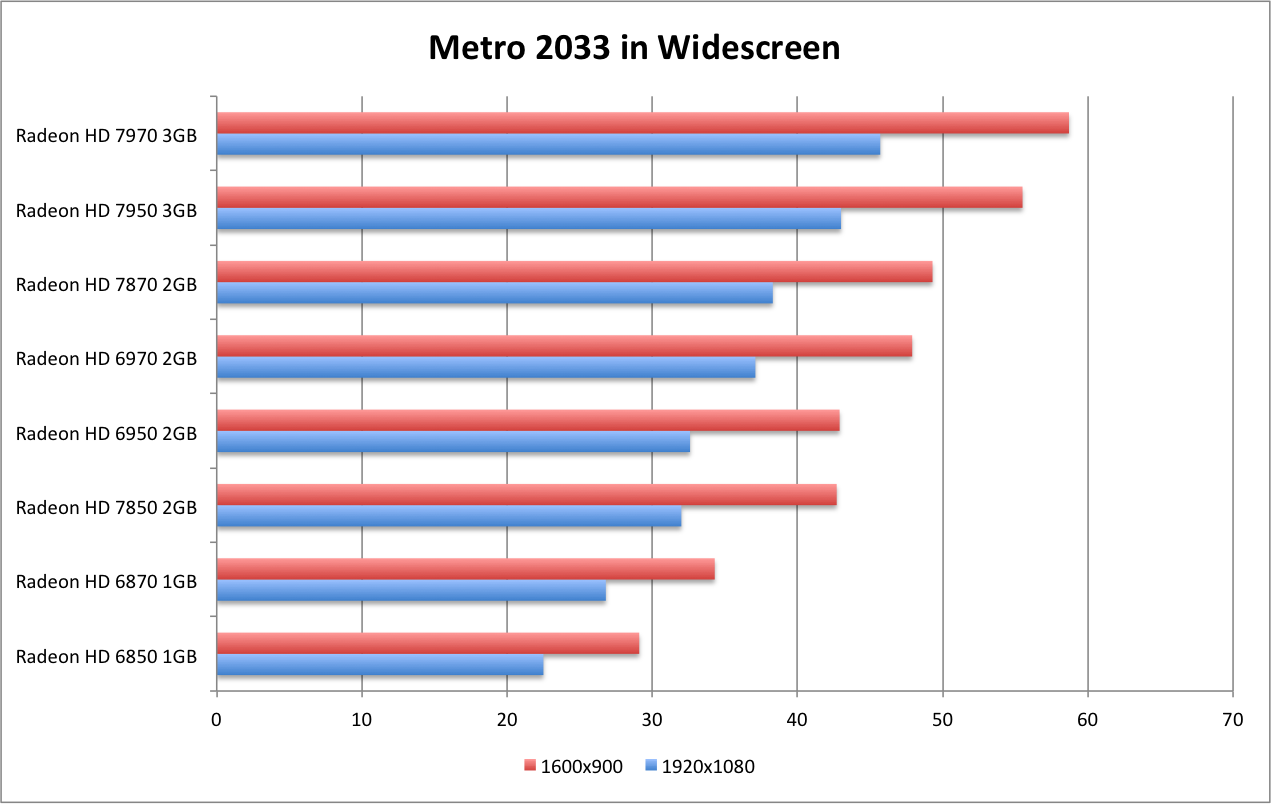
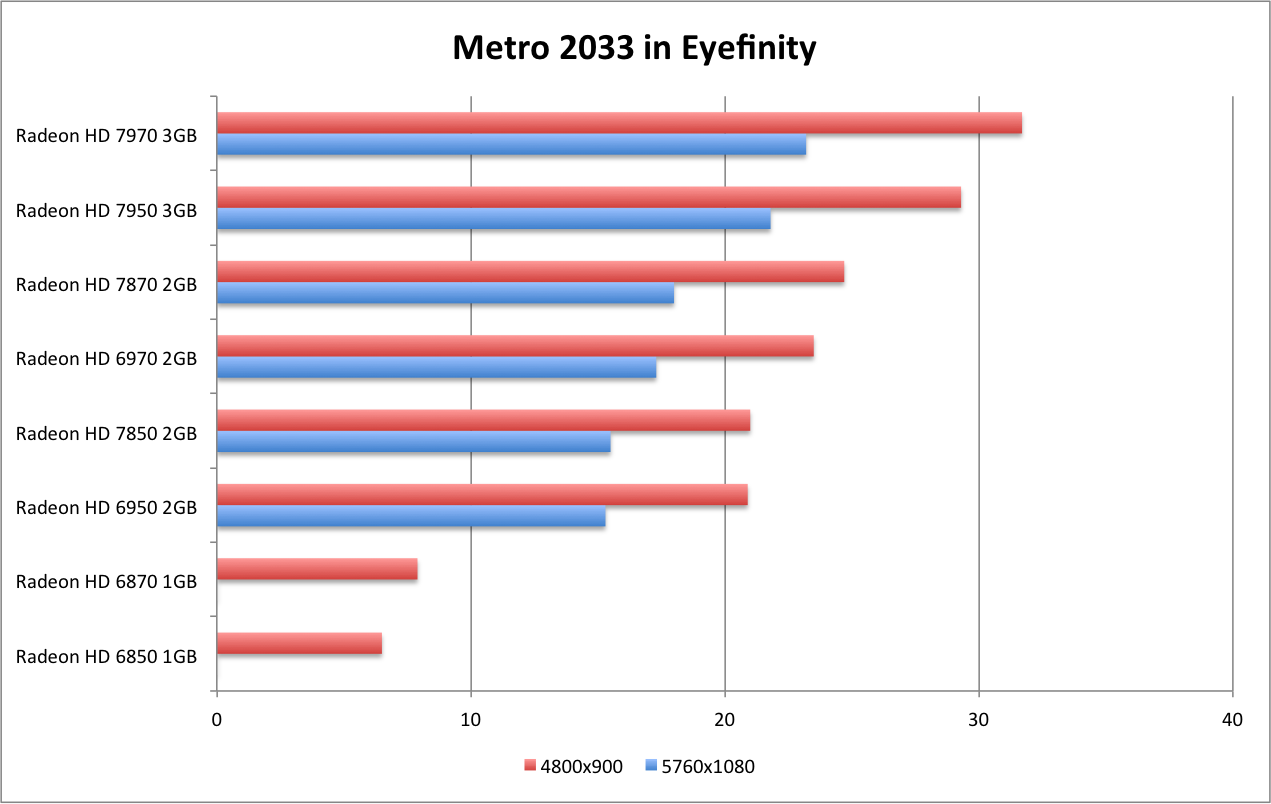
AMD Radeon HD 7870 GHz Edition & HD 7850 Review - Total War: Shogun 2
Benchmark that is included in Total War: Shogun 2. This is the one instance we are not running at full "max" settings with 4xAA/16xAF. The benchmark simply will not run at these settings in Eyefinity on any 1GB card. To enable a consistent benchmark across all cards I've used these settings: "Very High" preset, 2xAA, and all the DX11 options turned on.
The Shogun 2 benchmark has a unique feature in that it will not let you overrun the frame buffer. If it finds your graphics card doesn't have enough VRAM, then it simply fails to run and makes suggestions on what settings you can reduce. Running the game at these settings at 1080p, the benchmark tool reports back that you've over spent the graphics card VRAM by 1MB. So, at "close to" maximum visual fidelity, this is our first benchmark that needs 2GB for 1080p gameplay. We have plenty of games that require 2GB to play Eyefinity at 1080p, but this is the first time we've seen a 2GB requirement for single screen.
The title showcases a number of scenes - both broad views of large scale battles (with large numbers of units), and highlighting the detail in marching columns of soldiers.
The Radeon HD 7870 pulls well ahead of the HD 6970, due to it's faster core clock speed. The HD 7850 performs on par with the HD 6950, and 2GB of VRAM is the entry point into playing Shogun 2 at 1080p with 2xAA.
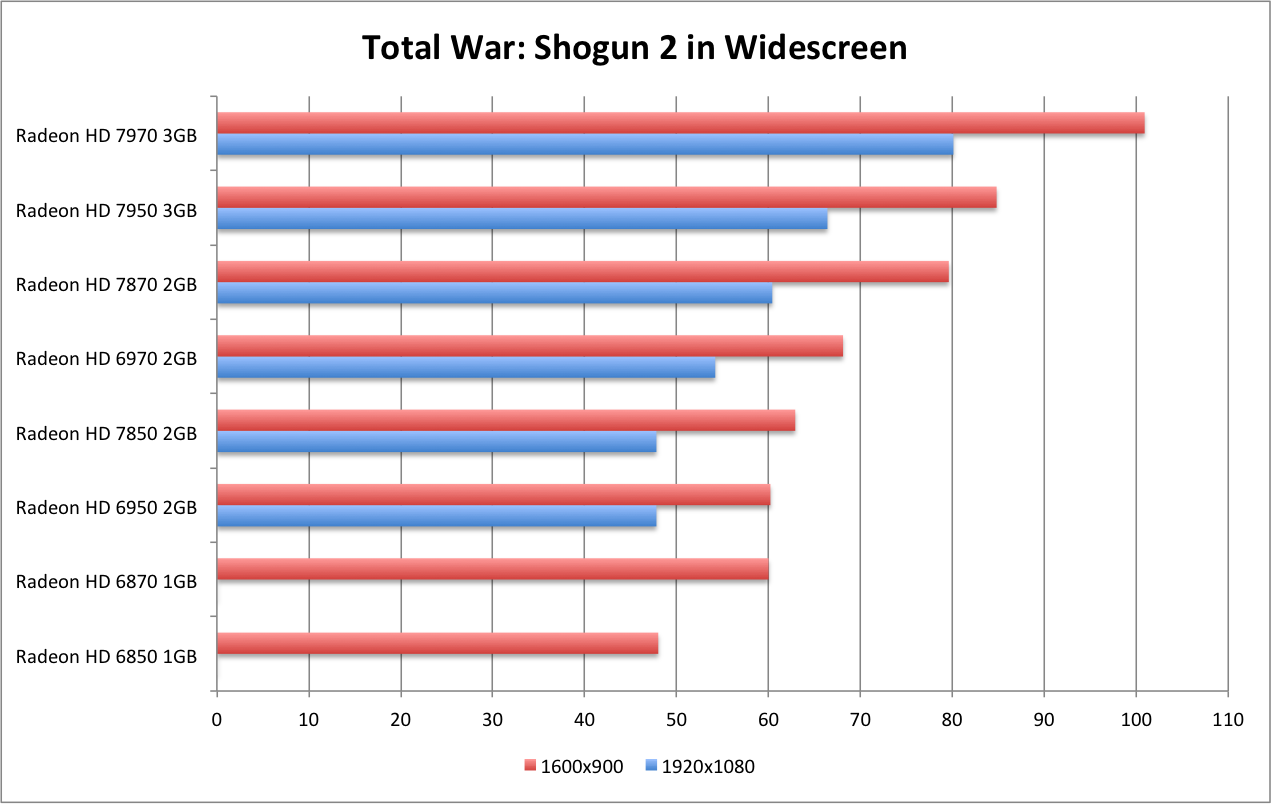
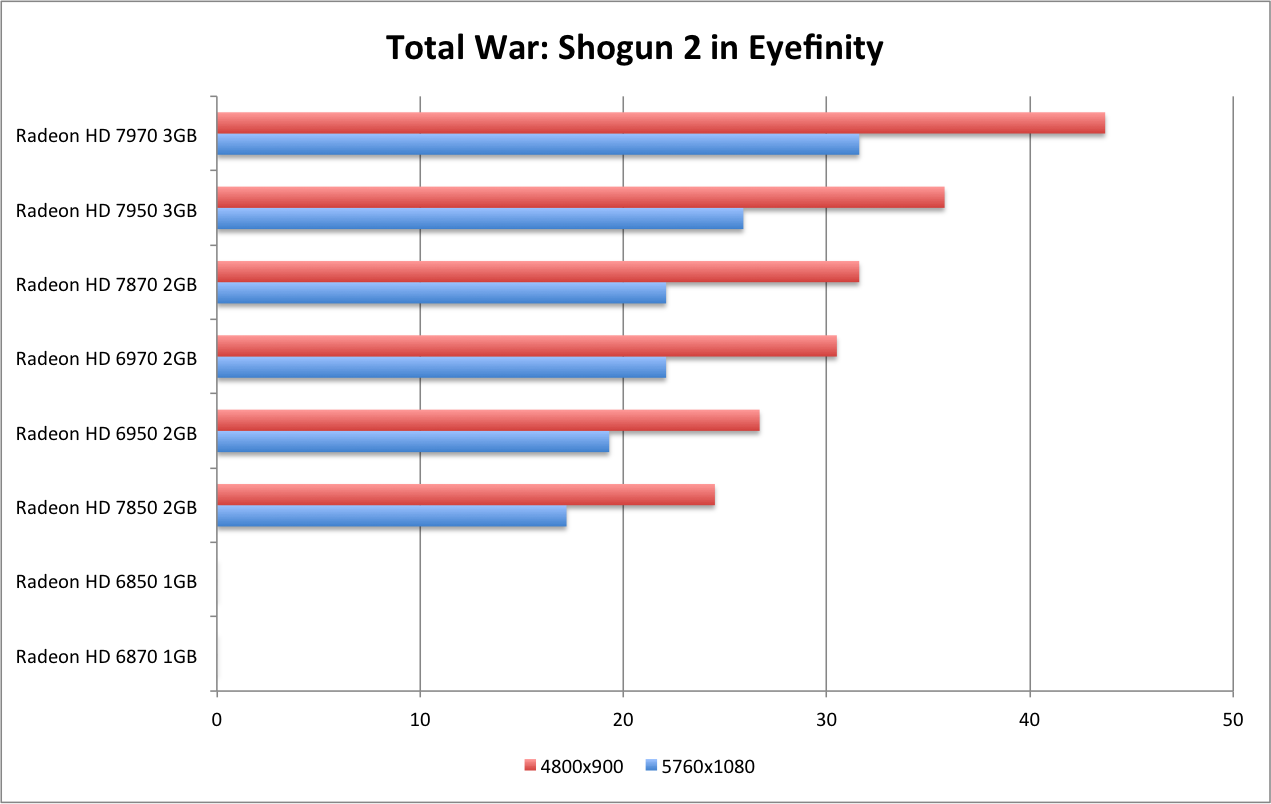
AMD Radeon HD 7870 GHz Edition & HD 7850 Review - Conclusions
The Radeon HD 7800 series is not a sizable improvement over the HD 6900 it replaces (from a price and spec point), and I think AMD realizes this. Over the last two generations they have expanded the x900 family to hold their flagship SKUs, and beef up the "performance" family (the x800 numbering) to include enthusiast class specs like a 2GB frame buffer. Even in their press materials, AMD is targeting users who purchased the Radeon 5870 two years ago, and are looking to an upgrade.
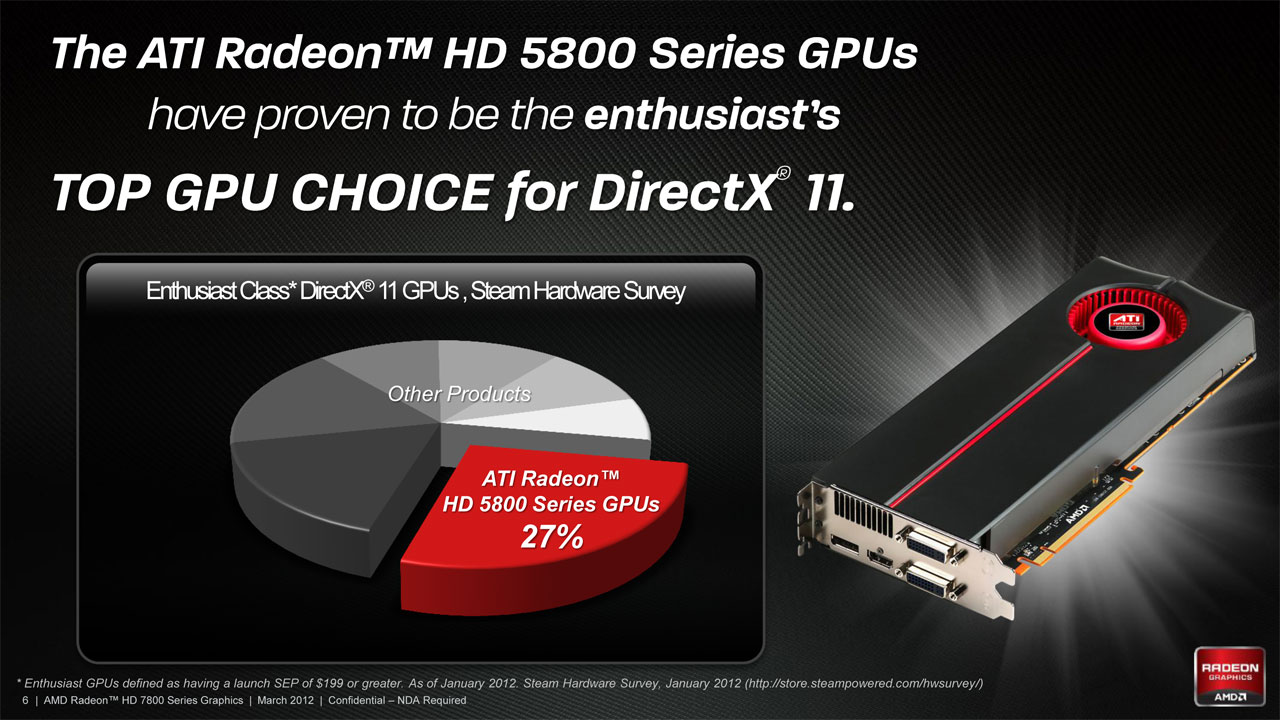

The Radeon HD 7870 GHz Edition and the HD 7850 solid performing cards - they just don't perform significantly better than their previous counterparts. It appears that for this iteration, AMD has deployed a "tick tock" model similar to the one Intel uses in its CPUs. The Radeon HD 7800 family does everything that the HD 6900 did, and does it (a bit) better. The real improvement is that it does it with far less power, and produces far less noise and heat - the results of the shrink to the 28nm process. The lack of significant performance improvements isn't necessarily a bad thing, and it's not something that can be expected in every generation from any company. Improving efficiencies is always good, and lays the groundwork for future improvements. The Radeon HD 6900 family was a significant improvement over the previous generation, and the Radeon HD 7800 improves the performance slightly from there.
If you're in the market for a new card (and if you own a 5000-series, you should be), then the Radeon 7800 family is a great performer, is a good value, and is very efficient at what it does. However, if you already have a 6000-series card, and are looking to upgrade, then you're going to have to jump price points to get significant improvement. If you have a Radeon HD 6800 card, then the HD 7900 will make you happy with its faster shaders, more shaders and more VRAM - you'll just need to spend about $100 more than you did on your last card. However, I think the increase in VRAM alone is worth it.
If you already have a Radeon HD 6900 series card, you'll need to shell out an extra $150 - $200 (beyond your last purchase price) to pick up a Radeon HD 7900 series to see any real improvement. Problem here is, the Radeon HD 7900 just might be overkill for you. And, you may be better served picking up a second 6900 card and going CrossFire.
Final Thoughts
We've had a look at all the single-GPU cards from AMD that I would consider in the "gaming" class. Anything below the Radeon HD 7700 family isn't really feasible for gaming. As this wraps up the bulk of our coverage on the Radeon HD 7000 series, I'm going to use this opportunity to provide my view on the whole line.
HTPC / SFF Users - The Radeon HD 7750 is your card. It pulls 30fps in many of our tests - at full settings, 4xAA and 16xAF. It could certainly pull 30fps or greater in many games with a few tweaks to the graphical settings. The card is small, efficient and quiet. It's low power draw means it doesn't need any external power and is being released in a few silent/fanless options. There is simply no reason to look any lower for a SFF or HTPC GPU.
Casual Widescreen Gamers - The Radeon HD 7770 GHz Edition isn't a bad card, but it just doesn't knock my socks off. Performance wise, it generally comes in just at or below the Radeon HD 6850. You may be better served by finding a Radeon HD 6850 on the cheap.
Dedicated Widescreen Gamers - The Radeon HD 7800 series offers good performance and a 2GB frame buffer (providing some future proofing). You can hit 60fps in almost all the games we tested, with little to no tweaking off of max settings. If you play on a single screen, and you're looking at a 7900-class card, take this advice... Save some money, on the card and pick up a couple of extra monitors to dip your toes in the Eyefinity pool. The Radeon HD 7800 series will provide you excellent (60fps) widescreen performance, and will give you a playable (30fps) Eyefinity experience in a wide selection of games.
Eyefinity Gamers - In the past I've been on the fence about needing 2GB of VRAM for Eyefinity. My first reaction to the launch of the Radeon HD 5870 was, "Eyefinity users need 2GB - it's that simple. ATI should have launched with a 2GB option, especially for those EF users runing 5760x1200." A few months later with the Radeon HD 5870 Eyefinity6 launch I said, "Make no mistake about it - 2GB of VRAM is not needed to play any game today in 3x1 Eyefinity. However, you won't be able to do it at max settings and consistently hit 60fps. You will have to reduce quality, sometimes to the point of virtually abandoning the DX11 code path and feature set all together."
Come forward ~18 months, and my mind is made up. You need 2GB of VRAM. Games have advanced. Features such as tessellation, HDAO, soft shadows and motion blur (not to mention good old AA) are putting more and more strain on your frame buffer. We're even at a point were 2GB of VRAM is needed to run a title at 1080p with 2xAA (Total War: Shogun 2). If you're at all serious about Eyefinity, you need a card with 2GB. So, the Radeon HD 7800 family is your starting point. Should you upgrade to the 3GB Radeon HD 7900 series?
The 3GB frame buffer and increased shaders offers a large improvement over the Radeon HD 6900 series in Eyefinity. Put a pair of them together and you have the biggest, baddest Eyefinity rig - bar none. Problem is that a pair of Radeon HD 7900 cards will cost you a grand.
Hardcore Eyefinity Users - A pair of Radeon HD 7900 series cards is a force to be reckoned with. Problem is they are expensive. The impending Radeon HD 7990 will certainly be cheaper than a pair of Radeon HD 7950's. If you want a single card solution, the 3GB Radeon HD 7900 will give you the best performance and help future proof you (and you can add a 2nd card once prices drop). If you're willing to pay for two cards, I would wait for the dual-GPU offering to make your decision.